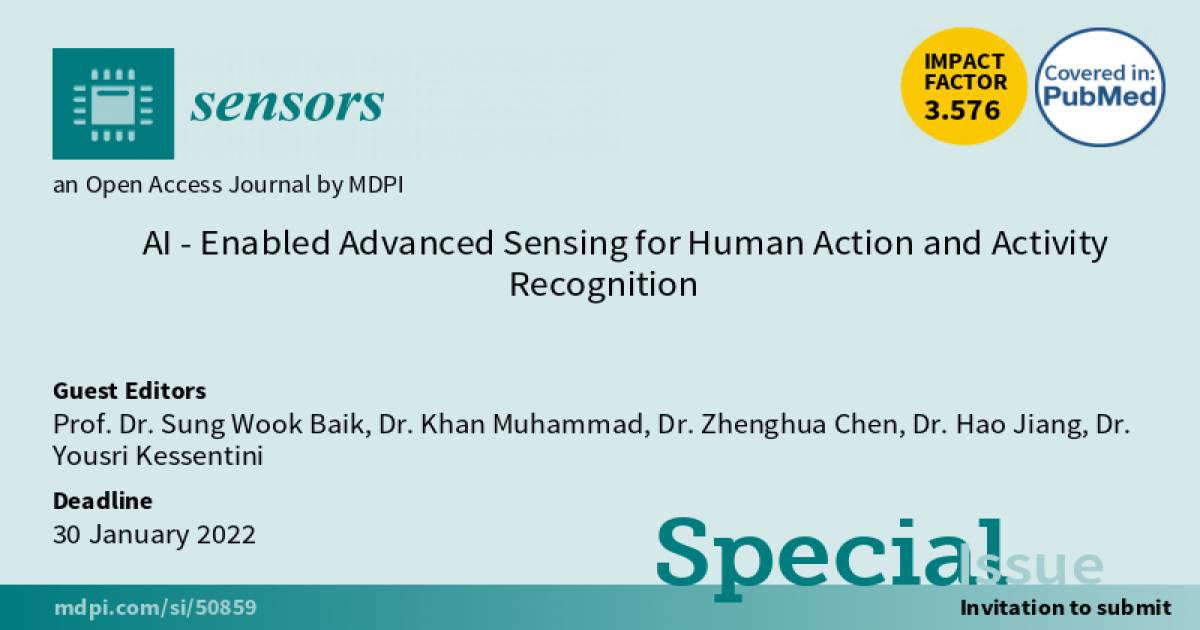AI-Enabled Advanced Sensing for Human Action and Activity Recognition
A special issue of Sensors (ISSN 1424-8220). This special issue belongs to the section "Intelligent Sensors".
Deadline for manuscript submissions: closed (30 January 2022) | Viewed by 53984

Special Issue Editors
Interests: Data Mining; Visual Mining; Computer Vision; Intelligent Robots; Mixed Reality; Cultural Property Restoration; Tourism Content; Digital Content Authoring
Interests: Action Recognition; Activity Recognition; Anomaly Recognition; Computer Vision; Video Analytics; Deep Learning; Video Summarization
Special Issues, Collections and Topics in MDPI journals
Interests: data analytics; deep learning; domain adaptation; self-supervised learning and related applications
Special Issues, Collections and Topics in MDPI journals
Interests: human activity recognition; Internet of Things; machine learning; deep learning; sensors enabled IoT; Smart Homes
Special Issues, Collections and Topics in MDPI journals
Special Issue Information
Dear Colleagues,
Recent emerging technologies to recognize human action and activity are functional for public security, assets protection, and human-actions/activities-analytics-based applications for healthcare and entertainment. Surveillance systems are installed at every edge of public zones such as parks, airports, and subways to record ongoing events. The necessity of these surveillance systems greatly increased the concern to protect human assets and reduce the risk of anomalies through automatic human activities analysis. Therefore, automatic real-time human action and activity recognition algorithms/methods are required, using different sensors’ data and their fusion (e.g., vision sensors, depth sensors, and skeleton sensors). Furthermore, the advanced smart sensor technologies in IoT and their improvement in embedded devices has brought a paradigm shift for secure surveillance to recognize human activities and overcome real-world anomalies. The main goal of these technologies is to emphasize computationally intelligent surveillance which integrates and designs several methodologies such as cloud computing, IoT, distributed computing, and embedded vision systems. These technologies can be integrated for the efficient and instant analysis of human activity recognition.
This Special Issue entitled “AI-Enabled Advanced Sensing for Human Action and Activity Recognition” calls for original works revealing the latest research advancements on conventional machine learning and deep learning methods that deeply analyze the structure of human actions and activity patterns from distinct kinds of sensor data or their fusion. These recognition methods need to be based on smart and innovative machine intelligence.
The topics include but are not limited to the following:
• Deep learning for action/activity/anomaly recognition.
• Spatiotemporal features extraction for human sequential patterns analysis.
• Lightweight 2D and 3D convolutional neural networks for human action/activity recognition.
• RGB/depth/skeleton sensors-based action recognition.
• Data prioritization prior to human activity patterns analysis.
• Violence recognition.
• Embedded vision for action/activity recognition.
• Sensors/multi-sensor integrations for activity recognition.
• Activity localization, detection, and context analysis.
• IoT-assisted computationally intelligent methods for activity recognition.
• Cloud/fog computing for action and activity recognition.
• Benchmark datasets for action/activity/anomaly recognition.
Prof. Dr. Sung Wook Baik
Dr. Khan Muhammad
Dr. Zhenghua Chen
Dr. Hao Jiang
Dr. Yousri Kessentini
Guest Editors
Manuscript Submission Information
Manuscripts should be submitted online at www.mdpi.com by registering and logging in to this website. Once you are registered, click here to go to the submission form. Manuscripts can be submitted until the deadline. All submissions that pass pre-check are peer-reviewed. Accepted papers will be published continuously in the journal (as soon as accepted) and will be listed together on the special issue website. Research articles, review articles as well as short communications are invited. For planned papers, a title and short abstract (about 100 words) can be sent to the Editorial Office for announcement on this website.
Submitted manuscripts should not have been published previously, nor be under consideration for publication elsewhere (except conference proceedings papers). All manuscripts are thoroughly refereed through a single-blind peer-review process. A guide for authors and other relevant information for submission of manuscripts is available on the Instructions for Authors page. Sensors is an international peer-reviewed open access semimonthly journal published by MDPI.
Please visit the Instructions for Authors page before submitting a manuscript. The Article Processing Charge (APC) for publication in this open access journal is 2600 CHF (Swiss Francs). Submitted papers should be well formatted and use good English. Authors may use MDPI's English editing service prior to publication or during author revisions.
Benefits of Publishing in a Special Issue
- Ease of navigation: Grouping papers by topic helps scholars navigate broad scope journals more efficiently.
- Greater discoverability: Special Issues support the reach and impact of scientific research. Articles in Special Issues are more discoverable and cited more frequently.
- Expansion of research network: Special Issues facilitate connections among authors, fostering scientific collaborations.
- External promotion: Articles in Special Issues are often promoted through the journal's social media, increasing their visibility.
- e-Book format: Special Issues with more than 10 articles can be published as dedicated e-books, ensuring wide and rapid dissemination.
Further information on MDPI's Special Issue polices can be found here.










